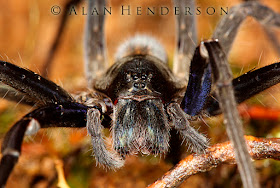The spider fauna on the Osa Peninsula is rich and diverse. All the species here are new to us of course, but some of the families are too. The most obvious spiders here are from the
Ctenidae; the wandering spiders. There are numerous species here and are easily spotted at night using a head torch. There are several species of tarantulas (Theraphosidae) here too, and we recently found a road side cutting with large numbers of hand-sized specimens (
Brachypelma angustum) sitting outside their burrows.
Every night we see more and more spiders. Here is a small selection of the spiders we have encountered so far - some of the smaller species are truly spectacular.
 |
| A 'leopard' wandering spider, Ctenidae |
 |
| Red-thighed Wandering Spider, Cupiennius coccineus |
 |
Costa Rican tarantula, Sericopelma sp.
|
 |
Male tarantula, 'Crypsidromus sp.'
|
 |
| Costa Rican Orange-mouth Tarantula, Psalmopoeus reduncus (female) |
 |
Male Costa Rican Orange-mouth Tarantula, Psalmopoeus reduncus (male)
|
|
 |
Costa Rican Orange-mouth Tarantula, Psalmopoeus reduncus
|
|
 |
| Silverback Cross Spider, Argiope savignyi |
 |
| A huntsman spider, formerly Olios now being reclassified. |
 |
| Flame-bellied Orb-weaver (Eriophora sp.), wrapping prey |
 |
| Flame-bellied Orb-weaver (Eriophora sp.) This species has a huge ladder-like orb-web which often connects with the ground. During the day they hide above the web in a curled leaf. |
 |
| A bizarre Lynx spider, Oxyopidae. This species lies flat underneath broad leaves. |
 |
| Not sure about this one - could be Oxyopidae or a Mimetid |
 |
| Pedipalps to be proud of. A male pirate spider, Mimetidae. |
 |
| The female of the same species. We could not identify this Mimetid beyond family level. The eye-spots on the abdomen make it look a little like a South Park character. |
 |
| Another individual of the same species. |
 |
| A Red house spider (Nesticodes rufipes). This species seems at home both in houses and within the rainforest. |
 |
| A small but robust Oxyopid feeding on a wasp. The spider is hanging from a strand of silk. |
 |
| Selenops sp. This lighting fast spider is at home on rocks and on tree trunks. |
 |
| The spiny Micrathena sexspinosa. A common orb-weaver on the Osa Peninsula. |
 |
| A large Scytodes sp.; a spitting spider. These six-eyed hunters eject venomous silk from their spinnerets. We were able to capture action in the studio. |
 |
| A jumping spider (Salticidae). |
 |
| A triangular orb-weaver, unknown species. |
























































